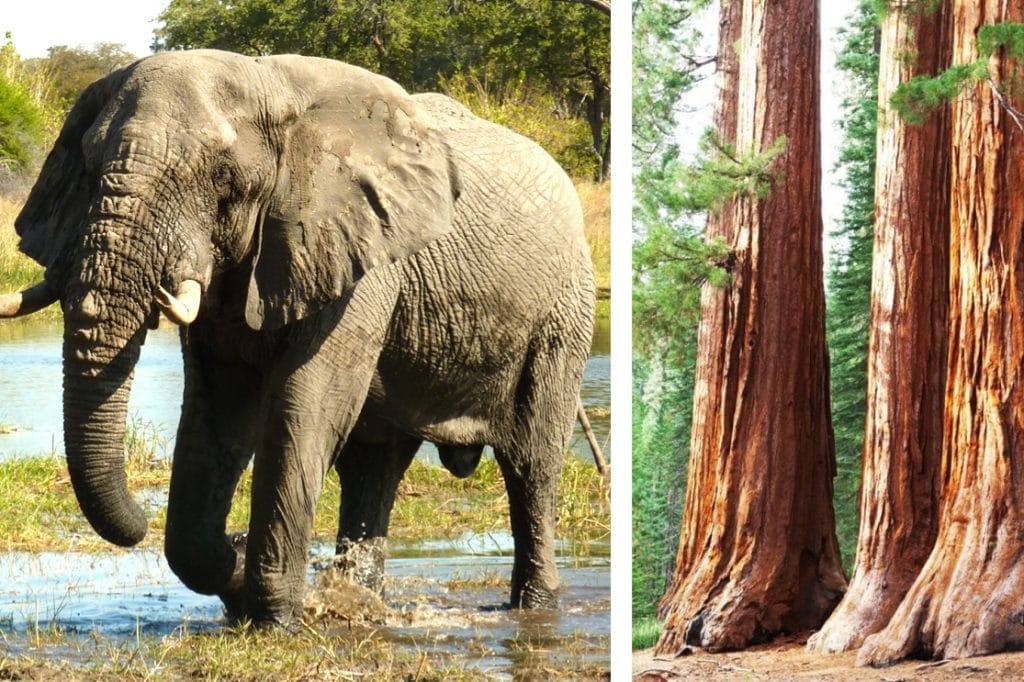What does the world look like without its largest plants and biggest animals?
What had always been a hypothetical question is becoming a daunting reality thanks to the culmination of habitat loss, big-game hunting, logging and climate change putting an array of species at risk. Researchers at Northern Arizona University and around the world have been asking themselves this question, determined to find the answer. A new study has confirmed what was already feared—not only are larger plants and animals at higher risk of extinction, but their loss would fundamentally degrade life on Earth.
A paper, recently published in Nature Communications, develops a new ecological theory to explain why large animals and plants matter so much for the health and integrity of all life on Earth. It found that ecosystems with large plants and animals are generally more productive and provide more vital ecological services, such as the removal of carbon dioxide from the atmosphere. However, these large organisms are more susceptible to human pressures and climate change and take longer to recover from shocks. Ecosystems that are missing large animals and trees are less resilient to change, less predictable and can collapse more easily.
Chris Doughty, assistant professor in the School of Informatics, Computing, and Cyber Systems at NAU and co-author on the recent publication, has long studied the effects megaherbivores have on the health of the planet and what their dwindling populations mean for Earth’s future. After realizing the impact can be attributed to more than just large animals, he started looking into the next biggest thing—plants.
“For this particular study, Chris and I examined how the loss of megabiota (the largest plants and animals) will impact the health of our planet,” said Ph.D. student Andrew Abraham, who worked with Doughty to conduct research. “Specifically, we ran two separate ecological models to look at ecosystem composition, energy consumption and nutrient movement in worlds with megabiota, and worlds without.”
One of the novel ecological models, dubbed the Madingley Model, allowed Doughty and Abraham to evaluate how the removal of the largest animals, such as mammoths, rhinos and bison, has impacted ecological networks across the world. By using these computer simulations to compare the state of the natural world in the Pleistocene period (before human-caused extinctions began), the present day and a future world in which all large plants and animals had gone extinct, the team was able to collect hard data.
The simulations found that the continued loss of large animals alone would lead to a 44 percent reduction in the total amount of wild animal biomass on the planet and a 92 percent reduction in soil fertility, which underpins the ability of the Earth to grow plants and sustain life.
A key reason for these results can be attributed to the transportation of nutrients and the lack thereof as large species disappear, according to Doughty.
“When large animals eat in one location and defecate or urinate in another, they transport nutrients, often moving them from nutrient-rich areas to other, less fertile, parts of the land and oceans. Without the large animals transporting nutrients, there are fewer nutrients available for plants, slower growth rates and potentially less carbon sequestration—thus possibly accelerating climate change,” he said.
“For hundreds of millions of years, Earth has been a planet of giants. In the last few thousand years, these large animals and plants have been whittled away, and this process continues today,” said co-author Yadvinder Malhi, leader of the Ecosystems Group at the Environmental Change Institute, University of Oxford. “Our paper shows why this loss of these giants matters for the very fabric of life on Earth and why we must do everything possible to protect and restore them.”
Doughty and Abraham collaborated on this publication with researchers from the University of Arizona, Santa Fe Institute, the UN Environment Programme World Conservation Monitoring Centre and the University of Oxford.



